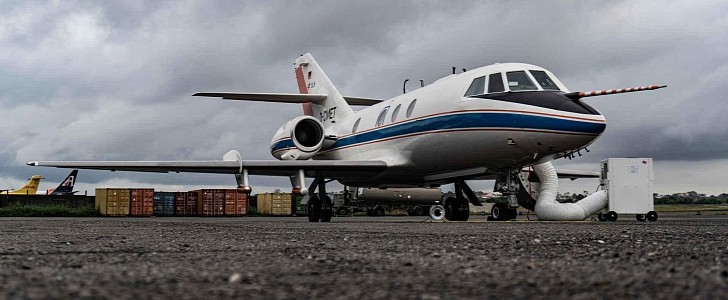The German Aerospace Center (DLR) is using its Falcon 20E research aircraft to measure methane emissions from the oil and gas industry as part of a wider commitment to help reduce the dangerous levels of this gas. The first mission was successfully carried out off the coast of Central Africa.
We are all familiar with the international goals for CO2 neutrality over the next decades, but there’s also a Global Methane Pledge initiated by the U.S. and EU, and backed by 100 countries. The goal is to reduce methane emissions around the world by 30%, by 2030, compared to the levels of 2020.
In order to get there, an accurate view of the current levels of methane emissions is essential. And that can only be obtained through detailed measurements. This is where the DLR Falcon 20E comes in. The flying research platform was used in a two-week study carried out this month by DLR from its base in Gabon, off the West Coast of Central Africa.
According to DLR, these particular emissions in the oil and gas industry are still underestimated or even unknown because even modern satellites can’t obtain detailed data above the ocean in challenging weather conditions. The Falcon aircraft was able to collect emission data by flying at a low altitude close to the offshore installations. It got as low as 30 meters (98 feet) above the ocean. Of course, this required obtaining specific permits and also setting up a dedicated base at the airport.
The mission was successful and will be followed by a similar one in Oman, next year.
The DLR Falcon 20E-5-D-CMET has been used for atmospheric research for more than four decades. Modified to be able to carry a huge payload of scientific instruments (up to 1,100 kg/2,425 lbs), the Dassault twin-engine jet is also able to fly much higher than conventional airliners and collect scientific data even in challenging conditions, such as thunderstorms.
In order to get there, an accurate view of the current levels of methane emissions is essential. And that can only be obtained through detailed measurements. This is where the DLR Falcon 20E comes in. The flying research platform was used in a two-week study carried out this month by DLR from its base in Gabon, off the West Coast of Central Africa.
According to DLR, these particular emissions in the oil and gas industry are still underestimated or even unknown because even modern satellites can’t obtain detailed data above the ocean in challenging weather conditions. The Falcon aircraft was able to collect emission data by flying at a low altitude close to the offshore installations. It got as low as 30 meters (98 feet) above the ocean. Of course, this required obtaining specific permits and also setting up a dedicated base at the airport.
The mission was successful and will be followed by a similar one in Oman, next year.
The DLR Falcon 20E-5-D-CMET has been used for atmospheric research for more than four decades. Modified to be able to carry a huge payload of scientific instruments (up to 1,100 kg/2,425 lbs), the Dassault twin-engine jet is also able to fly much higher than conventional airliners and collect scientific data even in challenging conditions, such as thunderstorms.






